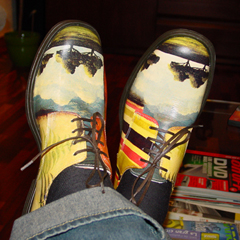Julián Álvarez (León, 1950) és llicenciat en Direcció i Producció Cinematogràfica per la London Film Academy (1974), estudis de Cinematografia a l'Escola d'Estudis Artístics de L'Hospitalet de Llobregat (Barcelona, 1975-77) i de vídeo/televisió a l'Escola Superior d'Art Dramàtic de Barcelona (CIPLA 1978-80). Resideix a Barcelona des de 1975 i ha estat partícip i coprotagonista decisiu de l'esperit de modernitat d'aquella Barcelona cosmopolita i activada per vídeo dels anys vuitanta i noranta mitjançant la docència audiovisual, l'experimentació i la creació videogràfica. És un dels pioners del videoart a l'Estat espanyol i la seva extensa videofilmografia, marcada per la seva heterodòxia experimental, segueix sent perifèrica als circuits artístics.
Iconoclasta i aliè a qualsevol etiqueta, tendència o adscripció grupal, Julián Álvarez es defineix com un autor que transita d'un mitjà a un altre, entre múltiples llenguatges, sense hipoteques disciplinàries o institucionals, mogut per una inquietud experimental i una actitud irònica que li permeten prendre certa distància respecte a les corrents audiovisuals en boga. Reconegui un cert grau d'excentricitat en les seves produccions i renuncia a la denominació d'artista, fent èmfasi en la seva qualitat d'autor, per a qui el procés d'elaboració i l'experiència amb la càmera com a «extensió orgànica del cos» són tan importants com el producte visual que finalment rep l'espectador. La seva obra, plena de paradoxes visuals i conceptuals, combina experiments d'ordre tècnic i formal –quasi autoreferencials– que remeten al període de les avantguardes històriques, amb poemes visuals de singular intensitat emocional; el (fals) documental, amb la ficció narrativa; les cites a la història del cinema, amb la deconstrucció irònica dels seus mites. Així és com la seva obra busca: "desdibuixar fronteres, contaminar identitats i sobretot: qüestionar certeses".
L'experimentació tècnica d'Álvarez es concretaria, a principis dels noranta, en la invenció i producció del prototip FishCam, sistema autònom de gravació per a suport mòbil de mini-càmera acoblada a una pértiga telescòpica, concebut, dissenyat i patentat per Julián Álvarez. Aquest sistema de gravació es converteix en una espècie d'extensió òptica, un ull telescòpic que potencia les capacitats de l'operador. Els aspectes tècnic-formals que concurren en la seva obra «tenen en general una aparença professional, però l'esperit que els va alentir en origen és experimental i amateur. Experimental perquè obeeix a l'impuls primari d'aprendre de l'experiència [experimentar] i amateur perquè estan plantejats per satisfer, en primer lloc, a un mateix. Són, doncs, experiències primigènies o, el que és el mateix, egocèntriques».
Davant de la unidireccionalitat de lectura que proposa majoritàriament l'audiovisual, Álvarez proposa despertar multiplicitat d'impressions. Davant de la lògica racional que fa avançar les imatges pel tradicional mecanisme de causa i efecte, l'autor persegueix les associacions plàstiques, rítmiques i la seva integració amb altres elements gràfics. I, per sobre de tot, la fascinació per la presència de la càmera, una càmera apèndix del braç, del cos, de la vista del realitzador que més enllà de tots ells es prolonga per estar a prop d'allò que persegueix. Gira per aconseguir tots els racons, batega, vibra, manifesta la seva curiositat i demostra com, desproveïda dels seus vincles novel·lístics i de les tiranies simplistes de la indústria, pot construir jugant; pot convertir un producte audiovisual en un gaudiós joc, on cada espectador trobi les seves pròpies lògiques per apropiar-se de la peça.
Autor-productor de més de 60 obres de creació i experimentació en vídeo, cinema i suports multimèdia, en paral·lel organitza i imparteix seminaris, tallers i conferències sobre cinema, vídeo, fotografia, televisió i publicitat en espais acadèmics i culturals (1976-82). Ha estat promotor i organitzador de la Mostra de Videos Realitzats a Barcelona (1983-1986) sobre art, música i realitat; organitzador i comissari de la Mostra de Videos Brasileños (1985), Mostra de Videos Italians (1986), entre altres; dirigeix el Primer Concurs Mundial de Càmera-a-mà i la mostra Del cinema-ull al vídeo-jo (La Caixa, 1987); estrena al Mercat de les Flors de Barcelona l'espectacle escènic i multimèdia El Ring (1988); presenta Boxiana a la Galeria d'Art La Pedrera (Barcelona, 1988), exposició entorn al boxeig que inclou vídeos, instal·lacions i pintures; presenta a la sala de festes Apolo (Barcelona, 1990) Macedònia de fruites Cirsa, que agrupa un concert amb el mateix nom i la performance Operació fimosi a partir del so de les màquines tragaperras. És Premi Nacional de Videografia de la Generalitat de Catalunya (1991), a més d'altres guardons i reconeixements estatals i internacionals. Quant a reconeixements, a més d'una trentena de premis nacionals i internacionals.
 http://www.juliansite.com/videofilmo.php
http://www.juliansite.com/videofilmo.php